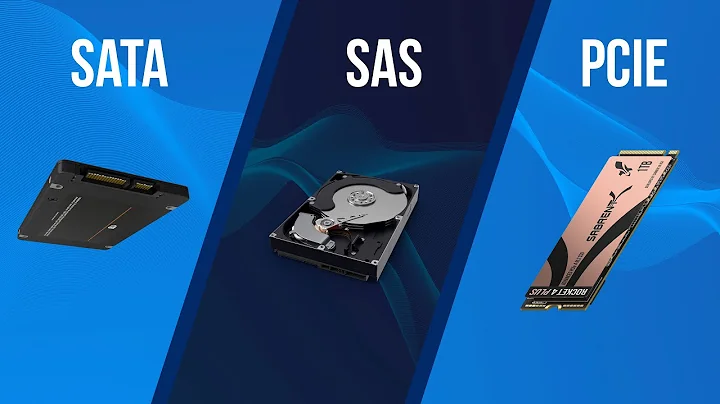SCSI vs SATA? Is SCSI "actually" better?
Solution 1
For SATA, you need to be careful about using a consumer drive if you are building a RAID array.
Some power saving features and in the case of Western Digital, some of their SATA drives have a "deep recovery" process when an error is detected. These can cause a SATA RAID member to be dropped or marked as failed if it is unresponsive beyond the timeout period.
When a SATA RAID5 volume with huge drives drops a member, it is not uncommon for the rebuild to take several hours. During this time, performance will be abysmal.
Western Digital - difference between Desktop edition and RAID (Enterprise) edition hard drives? http://wdc.custhelp.com/cgi-bin/wdc.cfg/php/enduser/std_adp.php?p_faqid=1397
http://en.wikipedia.org/wiki/Time-Limited_Error_Recovery
Solution 2
For the sake of simplicity when I say "SCSI" I'm talking about "traditional" SCSI and SAS
So, on the most basic level SCSI drives will be more reliable simple because they are built better. They are designed and priced to be put into high end machines - primarily servers where they will get a lot of abuse and quite possibly run 24/7/365 for 5-7 years. They are made of higher quality parts, etc. SATA drives are CONSUMER GRADE drives. They are made as cheaply as possible and are not designed with the kind of workloads Servers typically do in mind.
Just as an example, you wouldn't (well some may try but ... ) grab an off the shelf linksys router and try to push 100Mbps of internet traffic from 2000 clients through it.
As far as speed, you will actually see a fairly big difference in speed just do to the spindle speeds of the SCSI devices being so much higher. You're talking 7200 RPM vs 15k RPM on the high ends of both devices. The faster spindle speed, gives you lower latency and higher access speeds. The disk can push data out ... faster.
Deciding on the Drive to put into your machine is a lot more than the theoretical maximum data rate speeds of the interface. With SCSI drives you will get closer to that than with SATA drives.
Solution 3
Until recently, I would have agreed with the guy and said SCSI (or SAS) is a better solution than SATA. However, today's decent SATA drives are typically faster, more reliable, and cheaper than their SCSI equivalent. Here's an interesting article I read a while back comparing the two ( http://www.westerndigital.com/en/library/sata/2579-001097.pdf ).
Solution 4
For single-user/threaded apps the performance gap is very close but for anything multi-user or multi-threaded SAS/SCSI drives will be faster, often significantly. Also SATA disks will also be less reliable.
This is simply due to design, what they're designed to do when there's just a clean sheet of paper. It's also why expensive german cars are usually faster and more reliable than cheapo cars, extra time, effort and engineering has gone into the SCSI-spec and the build quality of SAS/SCSI disks - that's all, no magic, just effort and cost.
Oh and the thing about files and disks etc. is bullcrap :)
Solution 5
Until very recently, SCSI did tagged command queuing, which means that there could be up to 255 requests outstanding to the drive, which lets the drive optimize their order much better than IDE, which had at most 4 (?).
But now SATA supports it, and I don't think there is that much of a difference. Yes, the SCSI is probably better optimized for multi user/threaded io, but not sure how much that matters.
SCSI is mostly replaced by SAS and arrays of one sort or another. The other issue is, what are your requirements? Space vs speed vs cost? I might go for Solaris on zraid with flash drives for the log for cheap speed.
For a mere 100G, SSD is the way to go, as it is quite affordable, $3K would get you 4 Intel 64GB X25 Enterprise drives, put them in a software RAID10, and they would CRUSH just about any sane combo of rotating drives (SAS, SATA, SCSI, etc).
http://it.anandtech.com/IT/showdoc.aspx?i=3532
"For the rest of us, probably 90% of the market, the Intel X25-E is nothing short of amazing: it offers at least 3 to 13 times better OLTP performance at less than a tenth of the power consumption of the classical SAS drives. We frankly see no reason any more to buy SAS or FC drives for performance critical OLTP databases unless the database sizes are really huge. "
Related videos on Youtube
user971102
Hello there! My name's Jordan Earls, but most people online know me as "earlz". I'm the lead developer and a co-founder of the Qtum project which brings the Ethereum Virtual Machine (ie, the thing that makes Solidity contracts function) to a UTXO based blockchain similar to Bitcoin. I've been programming since I was 13 and am completely self-taught. Low-level code like assembly and pointer arithmetic is the fun stuff for me. I also make music when I have time even though it's usually awful. Most of my personal projects are open source and BSD licensed. The majority of them are at bitbucket with the rest of them being listed on github Also, you can follow me on the twitters @earlzdotnet
Updated on September 17, 2022Comments
-
user971102 over 1 year
Well, I was talking with a guy about servers the other day. I was a bit shocked whenever I asked him if there was any significant difference between SCSI and SATA and why he always uses SCSI. (note, I'm not sure if by SCSI he meant SAS)
He told me that SCSI is always faster and that the drives are always more reliable.. I mean, this seems like a bold statement.
He told me something about how SCSI will always be faster than SATA because the OS sends the SCSI (controller?) a request to get a file and it will build the file inside of the SCSI controller, instead of searching all over the disk.. which I do not understand how that would work, so I figure it is BS.
SAS and SATA currently have equivalent data rate speeds..
Is there any true backing for his reasoning that SCSI is always faster and more reliable than SATA?
-
Alex Holst over 14 yearsWhile SAS has some on-wire latency advantages over SATA, you'd need really fast storage device to tell the difference. As for reliability there's no difference between high-end SCSI gear and low-end SATA gear: labs.google.com/papers/disk_failures.pdf
-
user971102 over 14 yearsI am just having a lot of trouble finding a SATA and a SAS drive which are mostly equivalent(size and RPM) with pricing..
-
John Gardeniers over 14 yearsSAS is SCSI but with a different interface. SCSI is a LOT more than just the connector.
-
-
Eran over 14 yearsNope. No such animal as 15K SATA. 10K - yes (WD [Veloci]Raptors).
-
Zypher over 14 yearsAnd the [Veloci]Raptors are almost as expensive as SAS drives too ...
-
pboin over 14 yearsMy guess is that that the 'OS asking for the file' is actually a misinterpretation/misunderstanding of the fact that I/O processing is pushed off to an external controller for SCSI instead of running on the CPU as with SATA/IDE.
-
Javier over 14 yearsIDE=Integrated Drive Electronics. the innovation was that there was a controller in the drive that takes a block address and a read/write command, instead of the controller being in a 'controller card' (in an ISA slot) that directly drives the head actuators and interprets the raw magnetic signals from the head itself. old IDE chips did tax the CPU a lot more, because it had to read /write byte by byte to the chip. but that was long ago, all IDE is DMA-driven for more than a decade already
-
user971102 over 14 yearsbasically speed vs. cost with at least 100G of space(either by separate harddrives, or just one)...
-
user971102 over 14 yearsYes, this I knew.. PIO(iirc) is the slow mode for IDE (where it does a CPU interrupt to receive a byte from the harddrive)
-
 Admin almost 14 yearsGreg is referring to the tler, time limited error recovery, it being very short for Raid drives from WD and therefore will not drop that/those drives out of the array and hence cause it to sit in a degraded (assumed degraded) state. You will get a degraded array if the raid controller is waiting for a regular sata drive to recover, time out is too long on regular drives. This is true for controller cards like a 3ware card. If you were using a ZFS raid system from solaris you can use regular off the shelf workstation sata drives.
Admin almost 14 yearsGreg is referring to the tler, time limited error recovery, it being very short for Raid drives from WD and therefore will not drop that/those drives out of the array and hence cause it to sit in a degraded (assumed degraded) state. You will get a degraded array if the raid controller is waiting for a regular sata drive to recover, time out is too long on regular drives. This is true for controller cards like a 3ware card. If you were using a ZFS raid system from solaris you can use regular off the shelf workstation sata drives. -
HopelessN00b over 11 yearsOh, dear God. This is a bad answer. There's a reason SCSI (and SAS - Serial Attached SCSI) is considered enterprise grade, and SATA is not. The same reason, incidentally, that SATA drives are cheaper than SCSI ones. This, as I see it, is a dangerous answer, should anyone be foolhardy enough to replace their SCSI drives with SATA ones.
-
 Philip over 11 years-1 "More reliable" is only true for certain definitions of reliable - and there are very, very few SATA drives that are more reliable than a typical SAS drive. Glazing over the key differences between SCSI and SATA is dangerous at best.
Philip over 11 years-1 "More reliable" is only true for certain definitions of reliable - and there are very, very few SATA drives that are more reliable than a typical SAS drive. Glazing over the key differences between SCSI and SATA is dangerous at best. -
Magellan over 11 yearsWow. Just wow. SATA is definitely not "as good as SAS". Here's a good link for starters: serverfault.com/a/394600/73435
-
Magellan over 11 yearsThis one too: serverfault.com/a/394611/73435
-
 Hashim Aziz over 5 yearsWhy isn't this the accepted answer?
Hashim Aziz over 5 yearsWhy isn't this the accepted answer?




